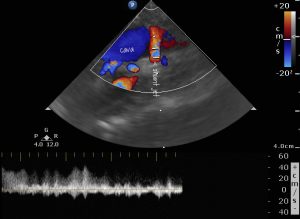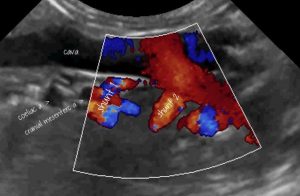Intrahepatic arterioportal fistula in a kitten
This patient is a five-month-old DSH with a history of ill-thrift and presumed hepatic encephalopathy (episodic hypersalivation, ataxia, blindness, seizures). Interestingly, her fasting bile acids were unremarkable. However, on abdominal ultrasonography there are all kinds of shenanigans:
First off, the left side of the liver contains a bizarre, aneurysmal dilation of the vasculature which communicates with both hepatic artery and left main portal vein branch.
Examination of the extrahepatic portal vein reveals caudally-directed, pulsatile, hepatofugal flow:
While the abdominal cava receives flow from the left renal vein in a normal position but with dramatically rapid, ‘fire hose’ fashion:
Moreover, this flow is also distinctly pulsatile. Normal cava and major abdominal vein flow fluctuates gently with the respiratory cycle: whereas this flow varies at the same rate as arterial pulsation.

Right long axis view of the abdominal cava shows a dramatic high velocity jet emerging from the left renal vein. Not only is it rapid…it’s also pulsatile.
The reason for this abnormal flow is revealed to be inflow from a portosystemic shunt vessel originating in the cranial mesenteric vein and coursing into the left renal vein:

right long axis view of the abdominal cava and its tributaries: the vessel labelled ‘shunt 1’ arises from the cranial mesenteric vein (running alongside the corresponding artery) and joins the left renal vein before it empties into the cava in a volcanic jet. The vessel labelled ‘shunt 2’ is another shunt arising from the cranial mesenteric vein and running off caudally into a plexus of vessels around the great vessels in the sublumbar area.
These findings are pathognomonic for an arterioportal fistula (subsequently confirmed on CT angiography in this kitten). In fact, although the first impression on sonography is of a nightmare tangle of abnormal abdominal vessels, it’s not absolutely necessary in the first instance to elucidate what communicates with what: the presence of convincingly pulsatile portal flow can only be explained by arterioportal communication. Invariably, the high arterial pressure pushing into the portal circulation drives the development of multiple portosystemic shunts . Flow then runs caudally from the point of communication through the main portal vein and thence into the shunt vessels.
J Small Anim Pract. 2006 Jun;47(6):338-43.
Ultrasonographic diagnosis of unusual portal vascular abnormalities in two cats.
McConnell JF1, Sparkes AH, Ladlow J, Doust R, Davies S.
https://www.ncbi.nlm.nih.gov/pubmed/16761986
The point of communication may be intrahepatic (as here) or extrahepatic.
Surgical ligation of extrahepatic communication has been reported:
Surgical management of a cat with hepatic arterioportal fistula.
Phillips A, Kulendra ER, Lam R, Kulendra NJ, Brockman DJ.
J Small Anim Pract. 2018 Mar 14
https://onlinelibrary.wiley.com/doi/full/10.1111/jsap.12820
Intrahepatic fistulae are less accessible. However, successful closure has been reported using coil embolisation:
JFMS Open Rep. 2016 Apr 7;2(1):2055
Hybrid technique coil embolisation for intrahepatic arterioportal fistula in a cat: case report.
Uemura A1, Haruyama T2, Nakata M1, Fukayama T1, Goya S1, Fukushima R1, Tanaka R1.
https://www.ncbi.nlm.nih.gov/pmc/articles/PMC5368710/
An alternative would be liver lobectomy (hemi-hepatectomy); which has been employed in similarly-affected dogs.





